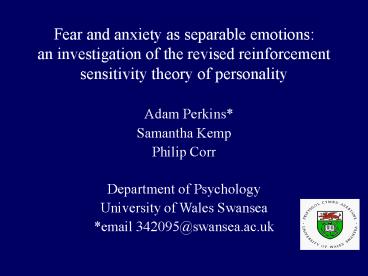Integrating Schizotypy: Perspectives from Cognitive Neuroscience PowerPoint PPT Presentation
1 / 14
Title: Integrating Schizotypy: Perspectives from Cognitive Neuroscience
1
Fear and anxiety as separable emotions an
investigation of the revised reinforcement
sensitivity theory of personality Adam
Perkins Samantha Kemp Philip Corr Department of
Psychology University of Wales Swansea email
342095_at_swansea.ac.uk
2
Ethoexperimental findings by the Blanchards
- Drugs that are effective against Generalized
Anxiety Disorder (GAD) reduce the risk assessment
and defensive threat/attack aspects of rodent
behaviour - Drugs effective against panic disorder reduce
flight without affecting other rodent defensive
behaviours - These results suggest that defensive reactions
form two clusters, each associated with a
different negative emotion fear and anxiety
3
Previous findings
- Typical correlations between fear and trait
anxiety/neuroticism are between .3 and .5 - Fear and trait anxiety/neuroticism therefore seem
not to be interchangeable - But no study so far has tested this statistically
4
Limitation of study 1
- Although numerous well-established questionnaire
measures of fear exist, they tend to have been
developed for the specific purpose of discovering
the focus of a patients phobia rather than
measuring personality per se
5
Aim of study 2
- To examine the extent to which fear questionnaire
scores account for unique variance in behaviour
in a military examination that tests tactical
judgement in combat scenarios
6
Fear facets measured by FSS
- Animal fear
- Social/interpersonal fear
- Tissue damage fear
- Noise fear
- Classic phobias
7
Subsidiary goal of study 2
- To examine the extent to which fear accounts for
variance in performance that is not accounted for
by other personality constructs including anxiety
8
Summary of research aims
- To explore Gray McNaughtons (2000) hypothesis
that fear and anxiety are separable a) by testing
correlations between relevant personality
questionnaire scores, b) by determining whether
fear scores account for unique variance in
performance in a non-clinical setting and c) by
assessing how fear and anxiety predict
performance in comparison to other measures of
personality.
9
Method
- Study 1 participants 141 members of the general
public (58 males and 83 females), aged between 18
and 77 (mean 29.03 SD 8.40), participated in
return for 8 payment - Study 2 participants 101 members of the UK
University Officer Training Corps (UOTC), aged
between 18 and 23 years (60 male, 41 female),
with an average age of 20 (SD 0.87)
10
Results of study 1
- Variable 1 2 3 4 5 6
- --------------------------------------------------
-------------------------------------- - Trait anxiety - -.033 -.216 .761 -.069 .291
- Psychoticism -.311 - .204 -.125 .013 .017
- Extraversion -.241 .131 - -.234 -.023 .023
- Neuroticism .741 -.183 -.074 - -.019 .352
- Lie -.097 -.213 -.044 -.180 - .324
- Total fear .205 -.209 -.066 .212 .041 -
- --------------------------------------------------
-------------------------------------- - Note. N 141 (correlations for 58 males in
lower half of matrix, 83 females in upper half of
matrix). - . p lt .05.
- . p lt .01.
11
Results of study 2
- Predictor of performance ß coefficients
- ----------------------------------------------
------------------------------------- - RST RST (facets) EPQ RST/EPQ
- --------------------------------------------------
--------------------------------------------------
----------------- - Trait anxiety -.193 -.213 - -.152
- BAS .310 .249 - .271
- Total fear -.198 - - -.215
- Animal fear - -.138 - -
- Social fear - -.159 - -
- Tissue damage fear - -.329 - -
- Noise fear - .113 - -
- Classic phobias - .060 - -
- Psychoticism - - -.033 .122
- Extraversion - - .297 -.009
- Neuroticism - - -.215 -.102
- --------------------------------------------------
--------------------------------------------------
----------------- - Note. N 101. Model 1 adjusted R2 .291, Model
2 adjusted R2 .284, Model 3 adjusted R2 .168,
Model 4 adjusted R2 .292. - . p lt .05.
- p lt .01.
12
Conclusions
- The present findings provide two levels of
support for Gray McNaughtons (2000) hypothesis
that fear and anxiety are separable first,
fear-anxiety correlations revealed that these
constructs are not interchangeable at the
psychometric level and, second, regression
analysis revealed that fear questionnaire scores
captured significant variance in performance that
was not shared with anxiety (and nor with any of
the other major personality constructs measured).
13
(No Transcript)
14
Fear and anxiety as separable emotions an
investigation of the revised reinforcement
sensitivity theory of personality Adam
Perkins Samantha Kemp Philip Corr Department of
Psychology University of Wales Swansea email
342095_at_swansea.ac.uk

